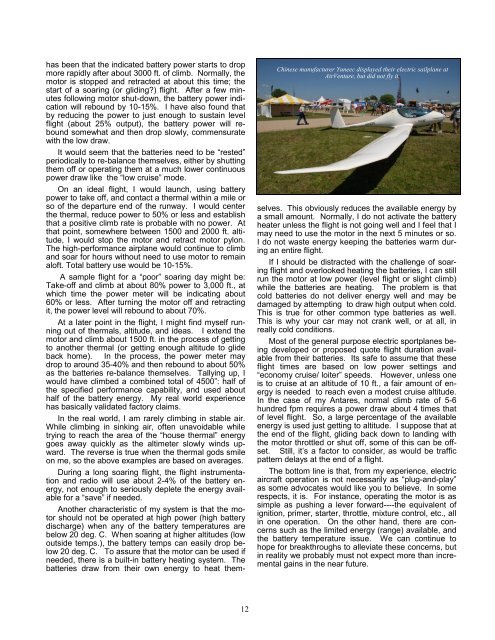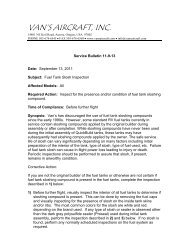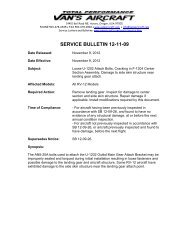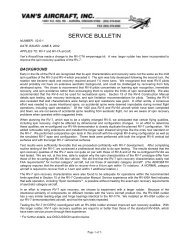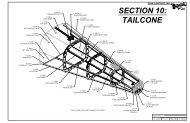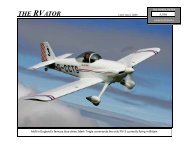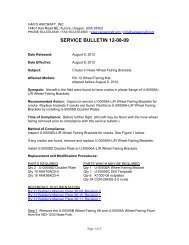You also want an ePaper? Increase the reach of your titles
YUMPU automatically turns print PDFs into web optimized ePapers that Google loves.
has been that the indicated battery power starts to drop<br />
more rapidly after about 3000 ft. of climb. Normally, the<br />
motor is stopped and retracted at about this time; the<br />
start of a soaring (or gliding?) flight. After a few minutes<br />
following motor shut-down, the battery power indication<br />
will rebound by 10-15%. I have also found that<br />
by reducing the power to just enough to sustain level<br />
flight (about 25% output), the battery power will rebound<br />
somewhat and then drop slowly, commensurate<br />
with the low draw.<br />
It would seem that the batteries need to be “rested”<br />
periodically to re-balance themselves, either by shutting<br />
them off or operating them at a much lower continuous<br />
power draw like the “low cruise” mode.<br />
On an ideal flight, I would launch, using battery<br />
power to take off, and contact a thermal within a mile or<br />
so of the departure end of the runway. I would center<br />
the thermal, reduce power to 50% or less and establish<br />
that a positive climb rate is probable with no power. At<br />
that point, somewhere between 1500 and 2000 ft. altitude,<br />
I would stop the motor and retract motor pylon.<br />
The high-performance airplane would continue to climb<br />
and soar for hours without need to use motor to remain<br />
aloft. Total battery use would be 10-15%.<br />
A sample flight for a “poor” soaring day might be:<br />
Take-off and climb at about 80% power to 3,000 ft., at<br />
which time the power meter will be indicating about<br />
60% or less. After turning the motor off and retracting<br />
it, the power level will rebound to about 70%.<br />
At a later point in the flight, I might find myself running<br />
out of thermals, altitude, and ideas. I extend the<br />
motor and climb about 1500 ft. in the process of getting<br />
to another thermal (or getting enough altitude to glide<br />
back home). In the process, the power meter may<br />
drop to around 35-40% and then rebound to about 50%<br />
as the batteries re-balance themselves. Tallying up, I<br />
would have climbed a combined total of 4500”: half of<br />
the specified performance capability, and used about<br />
half of the battery energy. My real world experience<br />
has basically validated factory claims.<br />
In the real world, I am rarely climbing in stable air.<br />
While climbing in sinking air, often unavoidable while<br />
trying to reach the area of the “house thermal” energy<br />
goes away quickly as the altimeter slowly winds upward.<br />
The reverse is true when the thermal gods smile<br />
on me, so the above examples are based on averages.<br />
During a long soaring flight, the flight instrumentation<br />
and radio will use about 2-4% of the battery energy,<br />
not enough to seriously deplete the energy available<br />
for a “save” if needed.<br />
Another characteristic of my system is that the motor<br />
should not be operated at high power (high battery<br />
discharge) when any of the battery temperatures are<br />
below 20 deg. C. When soaring at higher altitudes (low<br />
outside temps.), the battery temps can easily drop below<br />
20 deg. C. To assure that the motor can be used if<br />
needed, there is a built-in battery heating system. The<br />
batteries draw from their own energy to heat them-<br />
12<br />
Chinese manufacturer Yuneec displayed their electric sailplane at<br />
AirVenture, but did not fly it.<br />
selves. This obviously reduces the available energy by<br />
a small amount. Normally, I do not activate the battery<br />
heater unless the flight is not going well and I feel that I<br />
may need to use the motor in the next 5 minutes or so.<br />
I do not waste energy keeping the batteries warm during<br />
an entire flight.<br />
If I should be distracted with the challenge of soaring<br />
flight and overlooked heating the batteries, I can still<br />
run the motor at low power (level flight or slight climb)<br />
while the batteries are heating. The problem is that<br />
cold batteries do not deliver energy well and may be<br />
damaged by attempting to draw high output when cold.<br />
This is true for other common type batteries as well.<br />
This is why your car may not crank well, or at all, in<br />
really cold conditions.<br />
Most of the general purpose electric sportplanes being<br />
developed or proposed quote flight duration available<br />
from their batteries. Its safe to assume that these<br />
flight times are based on low power settings and<br />
“economy cruise/ loiter” speeds. However, unless one<br />
is to cruise at an altitude of 10 ft., a fair amount of energy<br />
is needed to reach even a modest cruise altitude.<br />
In the case of my Antares, normal climb rate of 5-6<br />
hundred fpm requires a power draw about 4 times that<br />
of level flight. So, a large percentage of the available<br />
energy is used just getting to altitude. I suppose that at<br />
the end of the flight, gliding back down to landing with<br />
the motor throttled or shut off, some of this can be offset.<br />
Still, it’s a factor to consider, as would be traffic<br />
pattern delays at the end of a flight.<br />
The bottom line is that, from my experience, electric<br />
aircraft operation is not necessarily as “plug-and-play”<br />
as some advocates would like you to believe. In some<br />
respects, it is. For instance, operating the motor is as<br />
simple as pushing a lever forward----the equivalent of<br />
ignition, primer, starter, throttle, mixture control, etc., all<br />
in one operation. On the other hand, there are concerns<br />
such as the limited energy (range) available, and<br />
the battery temperature issue. We can continue to<br />
hope for breakthroughs to alleviate these concerns, but<br />
in reality we probably must not expect more than incremental<br />
gains in the near future.


